Freight between China and Switzerland | Rates – Transit times – Duties & Taxes – Advices
The different methods of transportation between China and Switzerland
In this chapter, we have discussed and elaborated on the different transportation options between China and Switzerland, Sea, air, and rail, we can help you choose the most convenient and affordable way for your expedition.
Docshipper Note:
Need assistance with your shipment? Dont hesitate to contact us even for a simple question. Choose the option that suits you
Live chat with an expert Chat us on WhatsApp Fill the formDocShipper info
Docshipper is an international freight forwarder that meets all your needs by acting as your single point of contact through various logistics services. Relax, we take care of everything! From packing, to transportation, to customs clearance and administrative procedures, regardless of the shipping method (air, sea, road). Contact us today for a free quote within 24 hours.

Sea freight from China to Switzerland
Shipping from China to Switzerland
China is the second-biggest economy in the world and one of its most important trading partners of Switzerland. In 2019, Swiss manufactured exports to China amounted to 29.5 billion Swiss francs, whereas Swiss imports from China totalled 14.4 billion Swiss francs.
The main exports from Switzerland to China are machinery and equipment, watches, and pharmaceuticals, while the main imports from China to Switzerland are machinery, textiles, watch components, and chemicals.
Switzerland is a country landlocked because it has no access to the sea in the middle of Europe. However, there are two primary methods of delivering goods from China to Switzerland, by sea and air freight.
- From the ports of Antwerp, Rotterdam, Hamburg, Genoa, or Marseille/Fos, via ships, and then onwards through the EU by rail or truck, to locations in Switzerland.
- Through direct shipments from China to the port of Switzerland along the Rhine River. These containers are placed on a number of barges that travel up the river to the entry point of Switzerland and especially to the city of Basel.
The Port of Switzerland
Located on the Rhine, the Port of Basel, also called the “Port of Switzerland“, is a major logistics center for the whole country. It is composed of three ports in the two Cantons of Basel: The ports of Birsfelden, Basel-Kleinhüningen and Muttenz. The harbour in Basel-Kleinhüningen is the biggest of these.
Over 10% of all Swiss imports entering the Rhine from around the world via ports such as Amsterdam, Antwerp, and Rotterdam are treated in Birsfelden, Muttenz and Basel. As the port complex also includes a warehouse for the storage of petrochemicals, the Rhine ports have become a recognised hub of national significance for the Swiss economy.
The major terminals.
- 4 intermodal container terminals
- 385,000 m3 of grain silos
- 80,000 m3 of the warehouse for various bulk goods
- Tank for 1,250,000 m3 for liquid products
- 60 cranes with lifting capacities from 5 to 300 tonnes
DocShipper advice:
- Your cargo is larger than 2 m³.
- You have no time constraints
China and Switzerland Distance and Transit Time
It is extremely difficult to predict the exact transit times from the ports in China to Switzerland. The distance between China and Switzerland is 7 591 km bird’s flight.
Switzerland is not surrounded by any sea or ocean, which means that transport time varies greatly according to the destination port in Europe, the Swiss city being served, and the type of transport used in between. Generally, 30–40 days are required. The average transit times (in days) for the largest ports in China and Europe are listed below:
| Ningbo | Zhuhai | Hong Kong | Xiamen | Tianjin | Shenzhen |
| Fuzhou | Zhongshan | Shanghai | Foshan | Qingdao | Guangzhou |
What container can I choose to ship to Switzerland?
The following 3 different types of standard-size containers are available for the transport
- 20 ft (6.1 m) container with a volume of 33 m3 (about 10 pallets)
- 40 ft (12.19 m) container with a volume of 67 m3 (about 20 pallets)
- 40 ft (12.19 m) HQ container with a volume of 76 m3 (about 24 pallets)
For pallets of 120 × 100 cm (max height 230 cm)
The difference between LCL and Full Container Load (FCL)
Ocean freight is a dependable means of transporting high volumes, with various options available to accommodate different-sized cargoes.
Two of these are Full Container Load (FCL) and Less Than Container Load (LCL).
FCL designates shipments in which all the goods in the container belong to one party, whereas LCL refers to the goods of several shippers packed and shipped together in the same container.
A firm’s needs and stock requirements drive the procurement and dispatch decision, along with factors like cost and type of goods. For instance, LCL supports a smaller, more flexible inventory of items, while FCL is best suited for high-volume materials and high-volume products.
Advantages of LCL maritime groupage
- Pricing is according to the space used, depending on the volume occupied.
- Possibility of delivering small quantities when storage space is insufficient.
- Can be used for all different types of goods
Disadvantages of LCL shipping groupage
- Very long delivery time
- The merchandise must be palletized
- Significant manipulation (and therefore risk) in the groupage/deconsolidation warehouses.
Advantages of the Complete FCL Container
- You get all the space needed in the container
- Minimal handling. The container is sealed from start to finish
- Most cost-effective method for large volumes
Disadvantages of the FCL Full Container
- If you are in a hurry, sea transport remains the slowest method
- Minimum volume over 13/14 m³.
DocShipper advice:
The rate is usually a flat rate for the whole container. The cost per cubic meter is often cheaper than the estimated LCL cost per cubic meter. It will be cost-effective to use this method even if you only fill half the container.
Special transport
Reefer container
Reefer containers, popularly known as reefers, offer temperature-controlled transport, allowing your product, including meat, fruit, vegetables and dairy products, as well as pharmaceuticals and chemicals, to be transported across the world’s oceans at a controlled temperature so that they arrive in excellent condition.
Roro/OOG
A Ro-Ro is a vessel used to transport, apart from other things, vehicles, which are loaded by one or several ramps. Also known as Ro-Ro, from the English roll-on/roll-off, RORO is the cheapest and easiest way to ship vehicles.
The vehicles are taken directly to the RORO ship and secured on the vehicle decks. They are stowed securely inside the ship, watertight and windproof.
Bulk (Vrac)
Bulk goods consist of products transported directly into the ship’s hold or into installations provided for this purpose. In this case, a distinction is being made between bulk commodities and bulk commodities. Solid bulk products : (such as non-ferrous minerals, ferrous and coal) Bulk fluids: (oil and petroleum products). Bulk goods are transported by bulk carriers, ships specialized for each type of cargo: coal carriers, ore carriers, etc.
OOG
OOG (Out of Gauge) shipments are a special type of cargo. Because of, for example, their unusual size or weight, certain goods cannot be loaded in conventional containers. These kinds of cargoes are normally filled onto a flatbed or trailer for carriage.
Please feel free to consult our experts for any questions regarding China to Switzerland tariffs.
We offer standard-size containers as well as special shipping containers to Switzerland for personal and commercial goods.
How much to ship to Switzerland?
As Switzerland has no seaport, it is rather difficult to establish the price of transport by ship from China. It will mainly be determined by the additional mode of transport from the European port of arrival to the shipping destination in Switzerland.
Yet, sea transport is the cheapest mode of travel and the one most often used for high-volume shipments and bulky freight.
Contact us for a quote tailored to your needs.
For all requests, please ask our expert in overseas sea freight between China and Switzerland, who will work on a case-by-case basis to provide you with themost appropriate solution at a fair price. Complete our online form. You may also want to have a look at our specific page for more details on this method of transport: Sea Freight.
DocShipper advice:
As an international freight forwarder, we are able to handle different logistics operations such as sea freight. If you have an upcoming shipment and would like to rely on us and benefit from our experience in the sector, contact our experts via our form and receive a free quote within 24 hours.
Air freight from China to Switzerland
Airfreight from China to Switzerland
If your cargo has to be shipped fast, air freight is a better method compared to rail freight or sea freight. This way of doing things is also safer in terms of damage risk to the merchandise.
Switzerland now has 7 international airports. They are all located in all parts of the country, so selecting the best airport for your goods can save you a lot of time on ground movements.
Main airports in Switzerland
The 3 most frequented airports for freight aircraft directly to China are Basek, Zurich, and Geneva.
Zurich Airport – ZRH
Zurich Airport is frequently called Kloten Airport, not surprisingly it is also the busiest airport in Switzerland in terms of traffic for passengers and merchandise. The airport is located in the north of the city, about 13 km away, and is ideally placed for quick access to the city centre and the industrial area. It is the main hub for various Swiss airlines (Swiss global air lines, Swiss International Air Lines and Belair).
Airport Genève – GNV
Geneva airport is the second-busiest airport in the country, about 5Km from the city center. It is perfect for supplying your goods to the cities in the west of Switzerland.
Airport Bâle – BSL
EuroAirport Basel Mulhouse Freiburg is not only the airport of Basel but of several cities including Mulhouse and Freiburg. It is located in France, 3.5 km from the Swiss border, allowing it to transport goods to France, Switzerland and Germany. Its specialty is to welcome important air cargoes.
Main China Airport
- PEK – Beijing Capital International Airport
- CAN – Guangzhou Baiyun International Airport
- PVG – Shanghai Pudong International Airport
- SHA – Shanghai Hongqiao International Airport
- CTU – Chengdu Shuangliu International Airport
- SZX – Shenzhen Baoan International Airport
- KMG – Kunming Changshui International Airport
- XIY – Xi’an Xianyang International Airport
- HKG – Hong Kong International Airport
DocShipper advice:
- Your cargo is less than 2m³.
- If you have a deadline requirement
Why do we choose air transport?
Rapidity
The speed of air freight is unmatched by sea, road, or rail freight. It is very popular for the delivery of fresh produce, animals, and plants.
Security
Airports are very secure places, with strict regulations and controls, which benefit air shippers who know that their goods are being monitored, limiting risks and accidents. The unloading of the goods is done quickly, which further reduces the delivery time.
Places served
Air freight allows delivery to almost any location in the world, goods can be flown to the nearest airport and then delivered by road freight to its destination more quickly than with any other solution.
Monitoring
Airfreight companies offer a service that allows the tracking of your goods in real-time and their status during the entire transport.
Cost of packaging
Air freight lends itself to lightweight packaging and low material requirements. Packaging costs are therefore quite low.
Conventional or express air freight
Conventional air freight is suitable if your goods are around 1 to 2 m3, which is what standard airlines such as Air China, Emirates, Lufthansa, or Swiss Air usually do. Airfreight Express is designed to send small volumes quickly. The companies offering these services also provide door-to-door solutions. The price will be higher, but you will benefit from an efficient method and a very fast delivery. Companies offering this type of service include DHL, UPS, FedEx, and TNT.Visit our page dedicated to express air transport and, above all, call on our experts for all your questions or additional information, using our online form. You will receive an answer within 48 hours!
How much does it cost to transport cargo by air from China to Switzerland?
The main advantage of air freight is its speed, often used for small and light cargoes in a very short time.
However, it is the most expensive method, which is why this type of freight is less interesting for large volumes in some cases.
With this freight, you can know approximately how much it will cost you, we will see how to calculate air freight costs.
IATA basic fare
Air freight rates are based on a sliding scale of weight. The minimum price for air freight is €600.
- Price per kilo: €6
- Between 1000 and 2500 kg : 5€/kg
- Between 2500 and 3500 kg: 4€/kg
- More than 3500 kg : 3€/kg
Attention: The weight taken into account is the volumetric weight and not the gross weight of your goods
What is volumetric weight?
A law of equivalence is used by air carriers to respect the volumetric weight. The higher of the volumetric weight and the gross weight of the goods will be used. The following rules should be noted:
- Classic air freight: 1 m³ = 167 Kgs
- Express air freight: 1 m³ = 200 kgs
Important: Once your volumetric weight has been established to calculate the price of your cargo, it should be noted that airlines and airports apply additional fees and taxes.
We transport your cargo by air to various cities in Switzerland, including Zurich, Geneva, Basel, Bern, Lausanne, Lucerne, etc. We work with leading companies in the transport chain between China and Switzerland. We can therefore transport your products from any major Chinese city, such as Shanghai, Xiamen, Ningbo, Guangzhou, Shenzhen, or Hong Kong.
DocShipper advice:
If you need to ship products by air freight shipping to Switzerland, our experts are there to take care of all the logistic operations so that you can give time to develop your business. If you are interested in this service, contact our experts via our form, and you will receive a free quote within 24 hours.
Rail freight from China to Switzerland
Rail transport from China to Switzerland
Rail transport offers the advantage of speeding up maritime transportation and is cheaper than air transport.
A new alternative is proposed to reach China and Europe since 2011, this “new Silk Road” proposes a solution by rail freight for groupage cargo (LCL) or full containers (FCL)
To date, there is no direct route between China and Switzerland. At the moment, trains from China to Switzerland pass through German stations (Nuremberg, Hamburg and Duisburg). A direct solution between the two countries would be beneficial, as China is Switzerland’s second-biggest trading partner, after the EU.
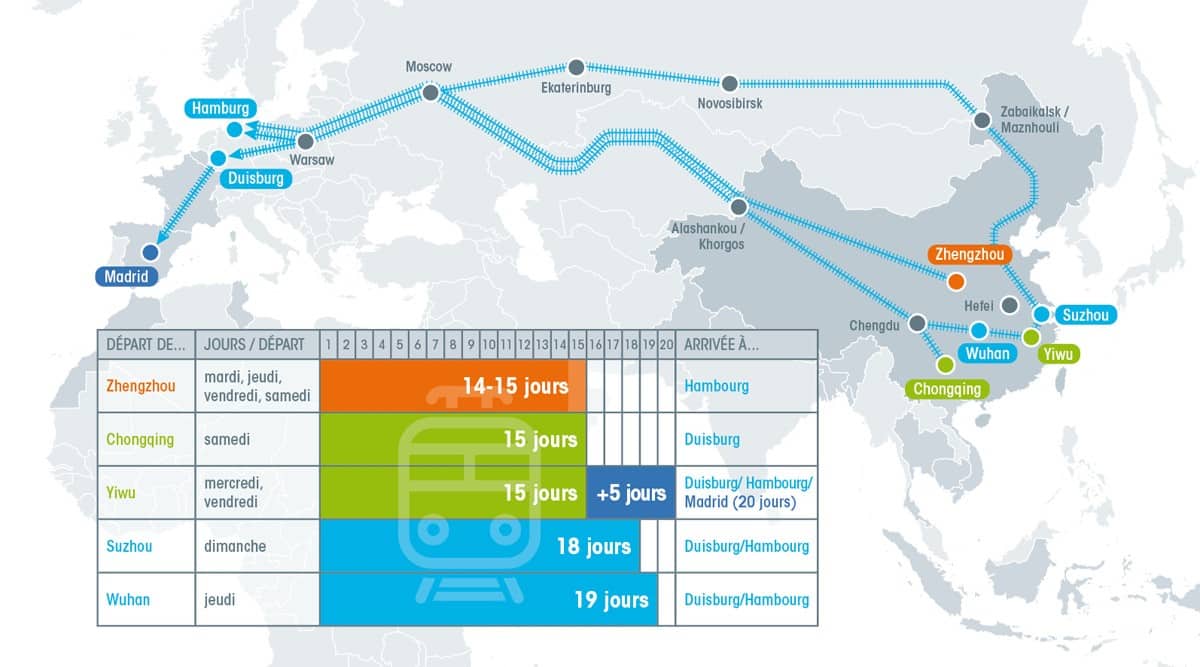
How long does it take to travel by train from China?
There are various possibilities for those wishing to transport their products by rail to Switzerland by rail. First, from China to Germany via the Trans-Eurasia, as, as illustrated below:
Chongqing, China → Duisburg, Germany (15Days)
Zhengzhou, China → Hamburg, Germany (15 days)
Changsha, China → Duisburg, Germany (18 days)
Haerbin, China → Hamburg, Germany (14 days)
Lanzhou, China → Hamburg, Germany (15 days)
Changchun, China → Hamburg, Germany (15 days)
Wuhan, China → Hamburg, Germany (16 days)
Wulumuqi, China → Duisburg, Germany (10 days)
Chengdu, China → Nuremberg, Germany (13 days)
- By another railway operated by the Swiss Federal Railways (SFB): Duisburg, Germany → Basel, Switzerland (1 day)
- By road: Germany → Switzerland (time and distance depending on the delivery location).
DocShipper trip:
Rail freight has been evolving over the last few years, so we recommend that you contact our team for more information. You can also take a look at our specific page: Rail freight.
What are the main advantages of the railway between China and Switzerland?
Reliability is one of the many interests of rail freight. It is a very good transport option compared to air freight or a combination of sea and air freight. Long delivery times to Europe are a major challenge for companies producing in China.
Compared to sea freight, rail freight is a reliable and fast means of transport with the shortest lead times. Sea freight from China to Switzerland normally takes six to seven weeks. Rail freight can halve the transport time, thus considerably reducing the lead time. This solution is particularly advantageous for companies operating in the fast-moving consumer goods sectors that are particularly concerned about delivery times.
The primary environmental benefit of rail freight is the reduction of exhaust emissions. When we compare the CO2 levels of the different types of transport, it is clear that rail freight transport is the winner.

Door-to-door delivery between China and Switzerland
The service, Door-to-door delivery, is the most common and convenient way to send your goods. The consumer is relieved of all the formalities involved in shipping. We take care of the whole process, from the beginning, from the recruitment and collection of all your goods, through the port/airport/rail terminal, and on to customs clearance and delivery at the destination. Door-to-door is above all a very practical and fast formula.
By combining our experience with the know-how of our staff in China and Switzerland, we can guarantee you quality service from A to Z. You will not have to do anything, and you may be relieved of some of your troubles.
This method saves you time and money!
Why are door-to-door services helpful?
A door-to-door service, just like its name indicates, involves collecting the goods from wherever you want them to be delivered to the address of your choice, right to your home or business. So the service is complete, whether by sea, air, express, or rail, and makes things much easier for you.
Safe delivery
When you entrust your cargo to us, you can be sure that it will arrive at its destination without any problems. All our partners guarantee a high quality service.
Professional staff
At Docshipper, one thing we are very pleased with is the friendliness of our team and their attention to detail. When you order your goods through us, you get an individual experience.
Tracking of shipments
Our staff will allow you to track the progress of your shipment at any time.
Are you looking for a reliable and safe door-to-door solution for transport between China and Switzerland? Then contact us! We will be happy to discuss with you the most appropriate solution for you.
Our team is here to assist you with the details of all your logistics requirements.
You may also wish to take a look at our special page: Door to door service

Customs clearance of goods imported from China to Switzerland
In this section, you will find the conditions and standards that must be met before you can import goods from China into Switzerland. You will find an overview and a directory to help you understand the general conditions for importing goods from China to Switzerland, as well as links to the main regulations in force in the country.
Switzerland, as we know, is in the middle of the EU, but not part of it. Therefore, if you decide to transit your goods by sea or rail from China, they must necessarily pass through EU countries. The regulation of transit in Europe is well regulated.
Currently, the Common Transit Regulation is applied in all EU countries for road, rail and air transport. The standard regime, known as NCTS (New Computerised Transit System), is carried out in an electronic format.
The tracking form is a genuine customs certificate. It is issued when the transit procedure is initiated and must be printed by you and accompany the shipment. The document also indicates whether the goods are in free circulation in the EU (T2 goods or Union goods) or in other assets (T1 goods).
Swiss customs value
To import goods into Switzerland, you must also take into account customs fees, VAT, transit clearance, etc. The Post Office, a public company of the Swiss Confederation, can offer you an estimate of the costs involved in importing goods from outside Switzerland. Switzerland uses the CIF (Cost, Insurance, Freight) valuation method to determine customs duties, as do the EU countries.CIF value = Insurance + Cost of goods + Cost of export clearance + Cost of transport to port of departure + Cost of transport to point of entry in Switzerland
Switzerland has a unique way of determining customs duties, as it depends on both weight and product (whereas most countries establish amounts based on value and product).VAT in Switzerland
The present tariffs apply as follows :
- Reduced rate of VAT: 2.5% (applied to certain everyday consumer goods such as food, water, newspapers, books).
- General Swiss VAT rate: 7.7%. (applies to most goods and services).
- Special rate of VAT: 3.7% (applies to hotels and establishments offering nighttime services).
- Exemption from Swiss VAT: financial services, insurance, health, education.
VAT is determined as follows: VAT rate x (duty rate+ customs value).
Customs duties in Switzerland. How to calculate them?
In order to find out what rate of duty is applied to your products, this information is available online free of charge. You can choose the date, country of origin, place of delivery and all related data to obtain the tax amount. We will guide you through the search process below. Like most countries, Switzerland applies the harmonised tariff system (HS) for exported and imported goods. Each commodity is assigned a HS code that represents a specific product. This code is used to determine the customs status of the product in each country where it is imported.
How to find the HS Code?
The best way to find out the HS code of your goods is to ask your supplier, who is best placed to tell you. In fact, if your supplier is used to marketing his products for export, he will certainly know the HS code. It is also possible to search the tariff library of each country using the “harmonised system” by simply entering a key term, such as “pineapple” in the example above. Indeed, we have prepared an example with all the steps of the process to find the HS code of your product and then calculate the customs duties. press “access the online service“, you will get to the next page:
press “access the online service“, you will get to the next page:
 Then click on “Nomenclature” to display this page, as shown in this demonstration:
Then click on “Nomenclature” to display this page, as shown in this demonstration:
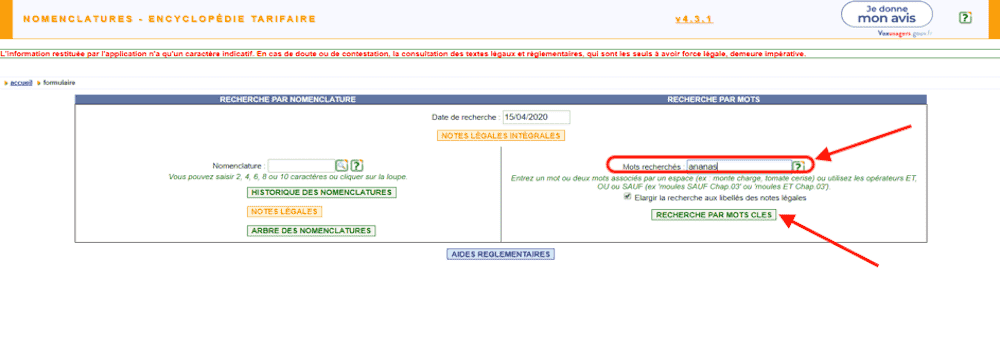 You will need to enter your “keywords” and then press “Search by keywords“.
You will need to enter your “keywords” and then press “Search by keywords“.
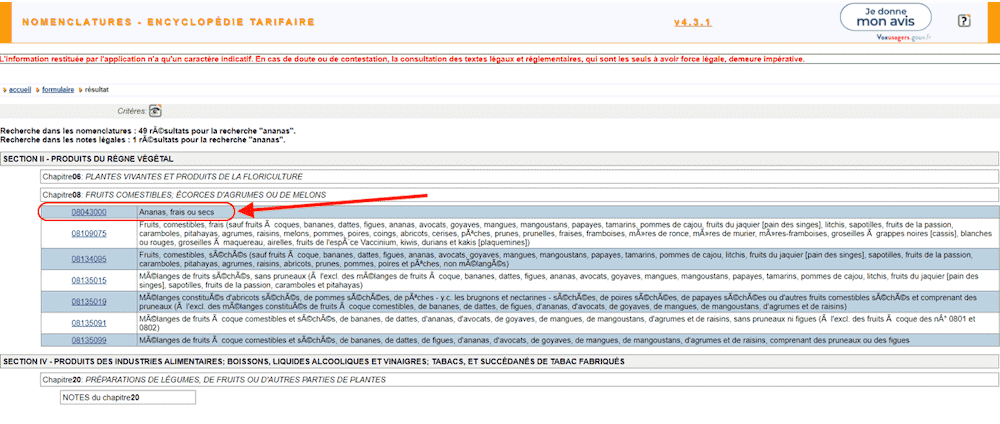
Calculating the customs duties with the HS Code
When you have the HS code for your item, it will be advantageous to determine the exact rate of duty for importing your goods from China to Switzerland. Go to the Swiss customs website. On the first page, by clicking on “enter“, you will arrive on a page that looks like this You must specify the country of origin of your item, as well as the HS code of the item. In the following example, we have chosen pineapple.
Once you have filled in all the details, you can click on “search” next to your HS code.
You must specify the country of origin of your item, as well as the HS code of the item. In the following example, we have chosen pineapple.
Once you have filled in all the details, you can click on “search” next to your HS code.
 Make sure it matches your item and press the little icon on the left of HS code.
The following page gives you more information:
Make sure it matches your item and press the little icon on the left of HS code.
The following page gives you more information:
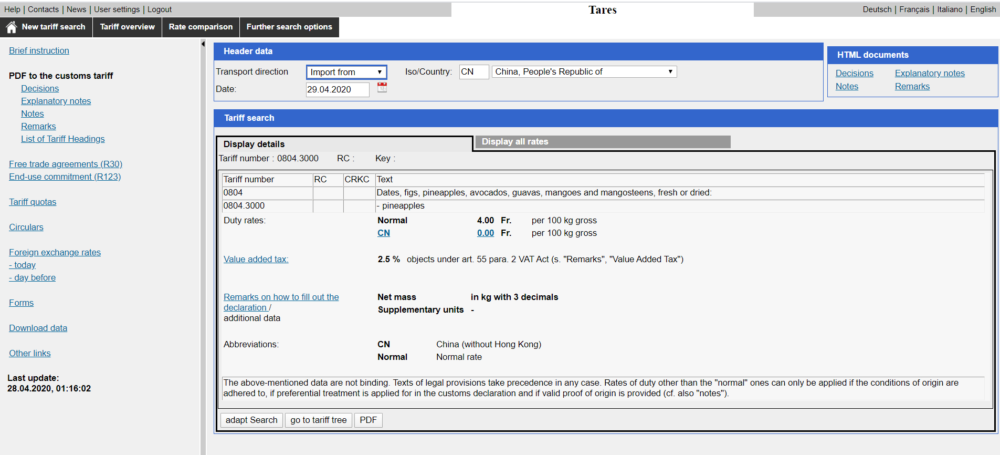
That’s it! You now know the taxes for importing pineapples from China to Switzerland. You will pay CHF 4.00 per 100 kg and you will benefit from a reduced VAT rate of 2.5%.
If you are planning to import goods from China, our specialists are able to conduct all customs procedures, you will just have to provide all the documents related to your goods. All you have to do is fill in our online form.
Does Docshipper charge customs duties?
Docshipper will not charge any commission on customs fees. Administrative documents, such as customs declarations, are sent to you after customs clearance. This will enable you to check that we do not charge any commission. In addition, Docshipper collects the costs of customs clearance. Our experts will take care of the administrative file so that you can declare it to the customs authorities. The government will collect the taxes and duties.Procedure and customs contact
DocShipper advice:
As you can see, Docshipper is far from being just an international forwarder. In fact, we take care of many other logistics operations such as customs clearance, or even packing and insurance! For more information, contact our experts via our form or directly by phone, you will receive a free quote within 24 hours.
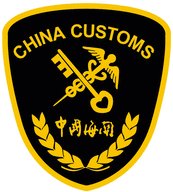
China Customs
Official name: General Administration of customs (China)
Official website: Chinese customs
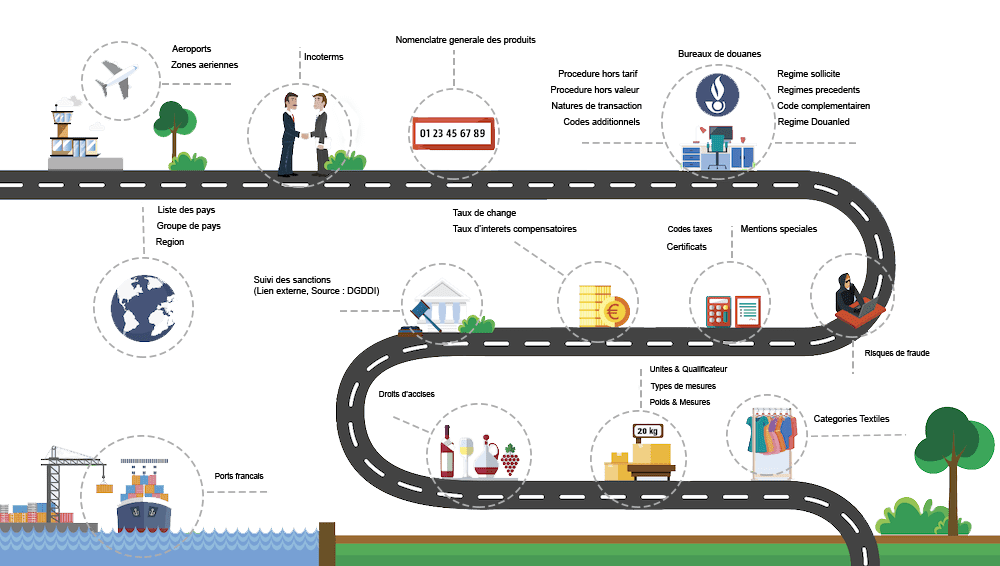
Bill of Lading
The purpose of the bill of lading is to guarantee the designated goods have been supplied by the exporter, in other words, it represents a certificate of transport.
The goods listed on this official document are covered by the terms of the freight company’s contracts with the shipper.
This document contains the prices of the products and the coordinates of the places of transport of the goods.
The bill of lading, as an official document, has legal value. All the data required to proceed with the shipment of the goods is contained in this document.
For air transport, this document is called “Air Waybill”.
Packing List
A form completed by the shipper that details the shipment including weight (gross and net), dimensions, contents, numbering of each package in the shipment and any identifying information features such as serial numbers. It also allows for the identification of damage or shortages, as the customer only pays taxes for what they have actually received.
Original Invoice
In China as well as in Switzerland, you have to attach the original invoice to get your goods through customs. Make sure there is no distinction between the original document and the checklist!
Certificate of Origin
Justifying the place of origin of your shipments, the certificate of origin is an essential element in world trade. It allows you to declare the country of origin of the goods.
It indicates the country of manufacture of the products, which should not be confused with the origin of the goods. This part is very important to allow importers and exporters to benefit from advantageous rates of customs duties, which are very advantageous for certain goods.
Please note: CE marking is not mandatory in Switzerland, although it is accepted for many product categories. However, the the product information, including the label, must be in at least one official Swiss language (Italian, German and French)
Import licences and permits
For certain items such as agricultural products, plants and others, a permit is required to bring them into Switzerland. Below is a summary of what you need:
Agricultural Products
- General import permit (GIPs) of the Federal Office for Agriculture (OFAG)
- Customs tariff number of the product
Plant products
- Or an import authorization issued by the Food and Veterinary Office (OSAV) for protected species.
- A phytosanitary passport issued by the FOAG is mandatory for plants.
- Moreover, some protected plant species are prohibited or only approved by the CITES convention.
Other special regulations in Switzerland
The “Swiss portal of technical rules” offers a presentation of the different products requiring specific conditions, including the following:
Industrial products
Thus, imported ships are required to comply with the regulations of the Ordinance on the circulation of ships in Switzerland.
Cosmetics, jewelry, wood and children’s items
Thus, hair dyes containing components hazardous to health are subject to the Ordinance on Household Goods and Foodstuffs.
If you are considering importing any of the above-mentioned products into Switzerland, we invite you to consult our experts. We will provide you with information on applying for permits, certificates, or other specific documents required.
Prohibited products
- Counterfeit products (textiles, accessories, medicines, electronics, etc.)
- Ivory
- Explosives
- Drugs
- Pornography
- Weapons
Are there any agreements between China and Switzerland?
Yes! The “Switzerland-China Free Trade Agreement (FTA)“
Initially, this arrangement was concluded between Switzerland and China in 2013, it entered into force shortly after. It consists of an agreement that sets the terms of the cooperative relationship between these two countries, with the aim of reducing trade restrictions such as import limitations and customs fees.
It is essential that every Swiss importer is aware of the benefits of this agreement.
We have outlined the key points of this arrangement for you:
Switzerland has lowered the tariffs for most products. As a Swiss importer, you can confirm whether the products you are interested in are on the list or, more importantly, what is not on the list. The Details of the decrease in the list of products are presented in the Annex I of the Agreement.
In order to obtain a reduced tariff, companies wishing to import from China to Switzerland are required to present a certificate of origin. For more details, you can consult Annexes II and III of the agreement.
Top 7 freight forwarders in Switzerland
- DocShipper
- Gandhi International Shipping
- HudHud Worldwide Logistics
- Fastar Logistics
- Pratama Expresindo Logistics
- Perfect Indy Transport Co
- Sahyog Logistics Solutions
Over 10 years of expertise in Asia has enabled us to offer customised transport solutions and proposals at ever more competitive prices. Do not hesitate to contact our specialised team for more information about your shipment, we are always happy to serve you and share our knowledge! Contact us
Other logistics services
Warehousing and storage
DocShipper offers a storage service. Our warehouses are strategically located near major cities in China and we take delivery of your goods. The storage period is determined according to your request, before shipment to the destination. We are also able to provide you with our services in terms of optimizing your entire container, whether it is for filling a complete container or for distributing your container with other suppliers. To learn more about our warehousing services, please visit our website!
Packaging and repackaging
The packaging and wrapping of your products are essential since they guarantee an excellent hold of the load during transport and offer a very good protection during storage and handling. We are able to realize such projects in China as well as in Switzerland. Therefore, if you have any requests for services such as: cardboard packaging, palletizing, wooden crates and others such as bubble wrap, adhesive tape... Please contact our experts : Packing Services

Transportation insurances
The rate: can be modified selon le type de transport, la composition de la cargaison, ... The insured value indicated by the subscriber (in principle national expenses + expenses related to the main transport), the uses authorize an increase of the guaranteed value of 20% at most. Therefore, you should be able to rely on this type of calculation to obtain a quote. This scale varies according to the nature/category of the goods. More info on our dedicated page: Insurance services
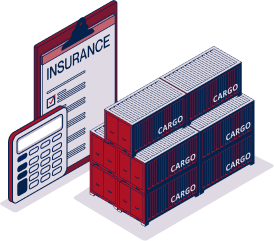
Supplier Management in China
In order to offer you a complete service and to assure you the right product, we contact your distributor beforehand. We will know more exactly the characteristics of the material covered by the Swiss standard and will examine them closely (especially the condition + packaging). Under our supervision, none of your products will leave the premises without proper packaging. Trust us, the process will be smooth from start to finish (no matter the incoterm). Our team is fluent in Mandarin/English/French and can check the dimensional characteristics and HS code of your items. More info on our dedicated page: Sourcing services
Shipment of personal effects
For any excess luggage, during an expatriation or upon return, Docshipper assists you with your formalities! Accessible worldwide, our services include packing, packaging, customs clearance, and of course the safe transportation of your belongings by our expert teams. For more information about our moving services, don't hesitate to visit our page!
3PL Service
Order processing/Packaging and labeling: The supply chain is a difficult process, especially if you don't know it. The same goes for distribution, with our warehouse in Camporosso, Italy (close to Switzerland), we store your stock and handle all your orders on a daily basis. We are your trusted partner, and take care of all services (packing, inventory, labeling, execution). The possibility of delivering to the last mile: Our partners with whom we have been working for a long time have enabled us to offer and ensure a shipment to any country at a very advantageous price and by guaranteeing you a quality service. More information on our dedicated page: 3PL services
FAQ -Freight between China and Switzerland | Rates – Transit times – Duties & Taxes – Advice
The cost of shipping from China to Switzerland depends on several factors, such as the size and weight of the package, the shipping method chosen and the distance between the origin and destination.
In general, there are many options for shipping a package from China to Switzerland: air freight, ocean freight, and express courier services such as DHL, FedEx, and UPS.
Air freight is generally the fastest option, but also the most expensive, while ocean freight is generally the most cost-effective, but can take several weeks for the package to reach its destination.
For a more accurate estimate of shipping costs, please contact DocShipper and provide us with detailed information about the package, including size and weight, desired shipping method, and origin and destination locations.
To get a quote for freight shipping from China to Switzerland, you can follow these steps:
- Determine the size and weight of your shipment: Measure the dimensions (length, width and height) of your package and weigh it accurately.
- Pick a shipping method: Decide which shipping method you prefer, whether it's air freight, ocean freight, or express courier services.
- Request a quote: Contact DocShipper, and give them details about your shipment including size and weight, origin and destination, and desired shipping method. You can request a quote online, by email, or by phone.
Here are some shipping methods you can consider for cost-effective shipping to Switzerland:
- Ocean freight: This is a good option for larger, heavier shipments that are not urgent. Sea freight can take many weeks to arrive at your destination, but it is mostly the most cost-effective shipping option. You can choose between full container load (FCL) and less-than-container load (LCL), depending on the size of your shipment.
- Postal Service: Many postal services offer international shipping options that can be affordable, especially for small packages. Delivery time may be longer, but this can be a good option for non-urgent shipments.
- Consolidation service: DocShipper offers consolidation services, which means that they combine several small shipments into one larger shipment. This can be a cost-effective way to ship small items because you can share the shipping costs with other customers.
- Freight Forwarder: Freight forwarders can offer competitive rates for shipments to Switzerland, especially if they have established partnerships with ocean carriers.
DocShipper will help you select the most cost-effective shipping option based on the size and weight of your shipment. It's important to note that while choosing the cheapest shipping option can save you money, it can also result in longer delivery times and less reliable tracking and delivery options. Be sure to balance the cost, delivery time, and quality that best meets your needs.
Shipping costs to Switzerland can be high due to several factors, including:
- Distance: Switzerland is located in the heart of Europe, and for shipments from China, the distance can be quite significant. Shipping over long distances can increase the cost of transportation.
- Customs and duties: When shipping to Switzerland, your package may be subject to customs clearance procedures and import duties, which may increase the cost of shipping.
- Shipping method: The shipping method you choose can also affect the cost of shipping. Express courier services such as DHL, FedEx, and UPS tend to be more expensive, but offer faster delivery times and more reliable tracking, while ocean freight can be more cost-effective, but may take longer to reach its destination.
- Fuel Prices: Fuel prices can also influence the cost of shipping, as carriers may adjust their rates to account for fluctuations in fuel prices.
- Packaging and handling: The cost of packaging and handling may also increase, especially if your package requires special handling or packaging to ensure safe transport.
It's important to note that shipping rates can vary significantly depending on the destination and details of the shipment.
- Freight from China to France | Rates – Transit times – Duties & Taxes
- Freight from China to Germany | Rates – Transit times – Duties & Taxes – Advice
- Freight between China and Belgium | Rates – Transit times – Duties & Taxes – Advice
- Freight from China to the US | Rates – Transit times – Duties & Taxes – Advice
- TOP 8 freight forwarders in Taiwan
We help you with the entire sourcing process so don’t hesitate to contact us if you have any questions!
- Having trouble finding the appropriate product? Enjoy our sourcing services, we directly find the right suppliers for you!
- You don’t trust your supplier? Ask our experts to do quality control to guarantee the condition of your goods!
- Do you need help with the logistics? Our international freight department supports you with door to door services!
- You don’t want to handle distribution? Our 3PL department will handle the storage, order fulfillment, and last-mile delivery!





